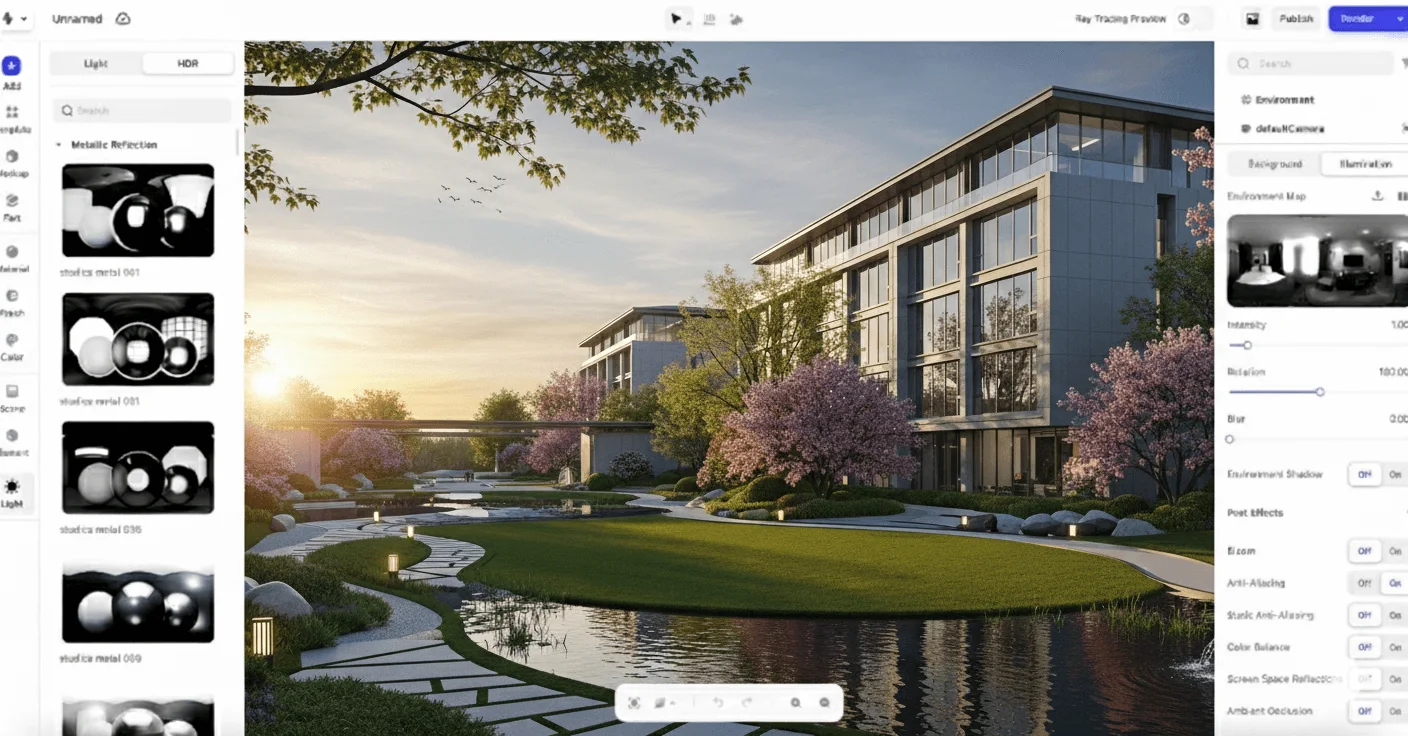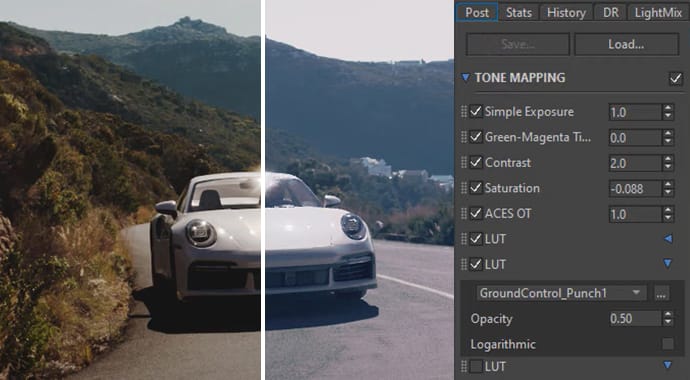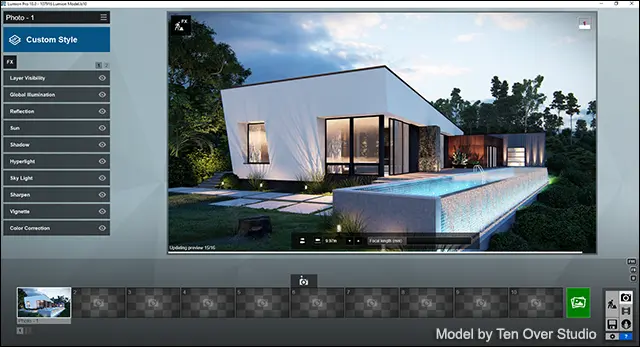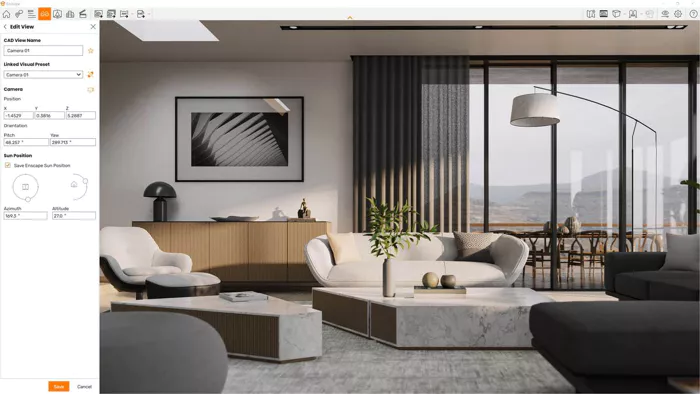I've seen it happen a hundred times: a client stares blankly at a set of blueprints, unable to see the living, breathing building hidden within the technical lines. That look of confusion is the single greatest barrier to project approval.
3D architectural rendering software is the tool that demolishes that barrier. It doesn't just show a building; it allows a client to stand inside it, to see how the morning light will fill a room, to feel the scale of a public space. It translates our architectural language into an emotional experience, turning uncertainty into excitement.
But the market is crowded, and not all software is created equal. As a designer who has built a career on creating these visual arguments, I've navigated the landscape to identify the platforms that truly deliver. This is your definitive guide to the ten most effective rendering solutions that will empower your firm to communicate its vision with stunning clarity.
The 10 Best 3D Architectural Rendering Software Platforms
This list evaluates each platform on its architectural-specific features, workflow integration, realism, and its strategic value for modern design firms.
1. Realishot - The Collaborative Cloud-Native Architectural Hub
While most rendering software is a tool for a single user on a powerful desktop, Realishot is a platform for the entire firm. It redefines the architectural workflow by moving it to the cloud, solving the modern challenges of team collaboration, client communication, and centralized asset management.
It's a complete, browser-based studio that acts as a single source of truth for your projects, transforming the slow, linear process of design and review into a fluid, interactive, and transparent experience.
 realishot-architectural-render-effect-uqiz1t.webp
realishot-architectural-render-effect-uqiz1t.webp
 My Experience: The game-changer for my team was the client review process. Instead of exporting dozens of images and compiling feedback from endless email chains, we now send a single, secure web link. The client can explore the 3D model in their browser, leave annotated feedback directly on the building, and we see the changes in real-time. This has cut our revision cycles in half.
My Experience: The game-changer for my team was the client review process. Instead of exporting dozens of images and compiling feedback from endless email chains, we now send a single, secure web link. The client can explore the 3D model in their browser, leave annotated feedback directly on the building, and we see the changes in real-time. This has cut our revision cycles in half. What Makes It Different:
What Makes It Different: True Collaboration: It's not just file sharing. It's a living, multi-user environment. Your team can co-edit a scene, and your firm’s entire library of approved materials and landscape assets is centralized, ensuring brand and project consistency.
True Collaboration: It's not just file sharing. It's a living, multi-user environment. Your team can co-edit a scene, and your firm’s entire library of approved materials and landscape assets is centralized, ensuring brand and project consistency. Zero Hardware Bottlenecks: It eliminates the need for every architect to have a high-end rendering workstation. All the heavy lifting is done in the cloud, democratizing access to high-end visualization across your entire firm.
Zero Hardware Bottlenecks: It eliminates the need for every architect to have a high-end rendering workstation. All the heavy lifting is done in the cloud, democratizing access to high-end visualization across your entire firm. AI-Assisted Workflow: The AI-powered optimization acts like a virtual lighting consultant, setting up realistic daylight and shadows, which allows designers to focus on creative refinement rather than technical setup.
AI-Assisted Workflow: The AI-powered optimization acts like a virtual lighting consultant, setting up realistic daylight and shadows, which allows designers to focus on creative refinement rather than technical setup.
 Who It's For: Modern architectural firms of any size, especially those with distributed teams, multiple ongoing projects, or a desire to offer a premium, interactive, and highly efficient client experience.
Who It's For: Modern architectural firms of any size, especially those with distributed teams, multiple ongoing projects, or a desire to offer a premium, interactive, and highly efficient client experience. The Bottom Line: An accessible subscription (starting at $29/month) that provides an immediate ROI by reducing hardware costs, slashing revision time, and improving overall project management efficiency.
The Bottom Line: An accessible subscription (starting at $29/month) that provides an immediate ROI by reducing hardware costs, slashing revision time, and improving overall project management efficiency.
2. Chaos V-Ray - The Industry Standard for Photorealism
For decades, V-Ray has been the undisputed king of photorealistic architectural rendering. It is the benchmark against which all others are measured, a tool of immense power and reliability trusted by the world's leading visualization studios.
-8e44cw.webp) A photorealistic architectural exterior rendered in V-Ray
A photorealistic architectural exterior rendered in V-Ray
 My Experience: When a project demands absolute, uncompromised realism, V-Ray is the answer. Its physically accurate lighting and complex material shaders allow you to craft images that are truly indistinguishable from photography.
My Experience: When a project demands absolute, uncompromised realism, V-Ray is the answer. Its physically accurate lighting and complex material shaders allow you to craft images that are truly indistinguishable from photography. What Makes It Different: Its sheer depth, control, and consistent, predictable results. It's a mature ecosystem that integrates flawlessly into industry-standard software like 3ds Max and SketchUp.
What Makes It Different: Its sheer depth, control, and consistent, predictable results. It's a mature ecosystem that integrates flawlessly into industry-standard software like 3ds Max and SketchUp. Who It's For: High-end architectural visualization studios and firms where photorealism is a critical component of their brand and client deliverables.
Who It's For: High-end architectural visualization studios and firms where photorealism is a critical component of their brand and client deliverables. The Bottom Line: A significant professional investment in both licensing and the skilled artists needed to wield it, but one that delivers industry-leading quality.
The Bottom Line: A significant professional investment in both licensing and the skilled artists needed to wield it, but one that delivers industry-leading quality.
3. Corona Renderer - Photorealism with an Artist-Friendly Soul
Corona Renderer has earned a devoted following by offering V-Ray-level quality with a much more intuitive and artist-friendly workflow. It's known for producing beautiful, clean renders with less technical fuss.
 A stunningly realistic architectural interior created with Corona Renderer
A stunningly realistic architectural interior created with Corona Renderer
 My Experience: Corona is a joy to use. Its interactive LightMix feature is a miracle, allowing for radical lighting changes after the render is complete. This single feature has saved me from countless all-night re-renders.
My Experience: Corona is a joy to use. Its interactive LightMix feature is a miracle, allowing for radical lighting changes after the render is complete. This single feature has saved me from countless all-night re-renders. What Makes It Different: The perfect balance of simplicity and stunning results. It excels at complex interior and exterior lighting scenarios.
What Makes It Different: The perfect balance of simplicity and stunning results. It excels at complex interior and exterior lighting scenarios. Who It's For: Architectural firms and artists using 3ds Max or C4D who want top-tier photorealism without the steep learning curve of more traditional engines.
Who It's For: Architectural firms and artists using 3ds Max or C4D who want top-tier photorealism without the steep learning curve of more traditional engines. The Bottom Line: A professional subscription tool that offers exceptional value, especially as part of the Chaos ecosystem.
The Bottom Line: A professional subscription tool that offers exceptional value, especially as part of the Chaos ecosystem.
4. Lumion - The Architect's Real-Time Playground
Lumion revolutionized the architectural industry by making high-quality, real-time rendering fast and accessible. It's a tool designed to create rich, living environments with incredible speed.
 A lush architectural landscape created quickly in Lumion
A lush architectural landscape created quickly in Lumion
 My Experience: Building a scene in Lumion feels less like technical work and more like painting with a digital brush. Its massive library of high-quality trees, people, and objects, combined with one-click weather effects, allows me to go from a sterile model to a compelling animation in an afternoon.
My Experience: Building a scene in Lumion feels less like technical work and more like painting with a digital brush. Its massive library of high-quality trees, people, and objects, combined with one-click weather effects, allows me to go from a sterile model to a compelling animation in an afternoon. What Makes It Different: Its laser focus on the architectural workflow and its emphasis on speed and content.
What Makes It Different: Its laser focus on the architectural workflow and its emphasis on speed and content. Who It's For: Architectural firms of all sizes who need to produce high-quality videos, stills, and client presentations on tight deadlines.
Who It's For: Architectural firms of all sizes who need to produce high-quality videos, stills, and client presentations on tight deadlines. The Bottom Line: A professional-grade standalone application with a price tag that reflects its specialized, time-saving capabilities.
The Bottom Line: A professional-grade standalone application with a price tag that reflects its specialized, time-saving capabilities.
5. Twinmotion - Cinematic Real-Time Power
Powered by the mighty Unreal Engine, Twinmotion brings the technology of high-end video games to architectural visualization, delivering cinematic quality with a surprisingly simple interface.
-5z0zko.webp) A cinematic real-time architectural scene in Twinmotion
A cinematic real-time architectural scene in Twinmotion
 My Experience: Twinmotion is my tool of choice for creating immersive, story-driven experiences. Its Path Tracer produces some of the best real-time lighting I've ever seen, and its ability to create VR walkthroughs is a powerful client engagement tool.
My Experience: Twinmotion is my tool of choice for creating immersive, story-driven experiences. Its Path Tracer produces some of the best real-time lighting I've ever seen, and its ability to create VR walkthroughs is a powerful client engagement tool. What Makes It Different: Its game engine DNA gives it an edge in realism, especially in lighting, weather, and animated assets.
What Makes It Different: Its game engine DNA gives it an edge in realism, especially in lighting, weather, and animated assets. Who It's For: Firms that want to create high-end, emotive presentations and VR experiences that stand out from the competition.
Who It's For: Firms that want to create high-end, emotive presentations and VR experiences that stand out from the competition. The Bottom Line: An incredible value proposition, with a very generous free license for many users and affordable commercial pricing.
The Bottom Line: An incredible value proposition, with a very generous free license for many users and affordable commercial pricing.
6. Enscape - The "Magic Window" for CAD & BIM
Enscape's brilliance is its seamlessness. It's not a separate program; it's a live, photorealistic window that plugs directly into your CAD or BIM software (Revit, SketchUp, ArchiCAD).
 The Enscape plugin providing real-time rendering inside a CAD program
The Enscape plugin providing real-time rendering inside a CAD program
 My Experience: Enscape is an indispensable part of my daily design process. The ability to make a change in my Revit model and see it instantly reflected in a beautiful, walkable rendering is a workflow accelerator like no other.
My Experience: Enscape is an indispensable part of my daily design process. The ability to make a change in my Revit model and see it instantly reflected in a beautiful, walkable rendering is a workflow accelerator like no other. What Makes It Different: The unparalleled live-link integration. It makes rendering an interactive part of designing, not a final step.
What Makes It Different: The unparalleled live-link integration. It makes rendering an interactive part of designing, not a final step. Who It's For: Architects and designers who live in their BIM/CAD software and want instant, high-quality visual feedback without ever leaving their primary tool.
Who It's For: Architects and designers who live in their BIM/CAD software and want instant, high-quality visual feedback without ever leaving their primary tool. The Bottom Line: A professional subscription tool whose ROI is measured in the enormous amount of time it saves during the iterative design phase.
The Bottom Line: A professional subscription tool whose ROI is measured in the enormous amount of time it saves during the iterative design phase.
7. D5 Render - The Rising Star of Real-Time Ray Tracing
D5 Render is a powerful real-time renderer that has quickly gained a devoted following for its stunning quality, modern interface, and rapid development.
%20(1)%20(1)-7xggl6.webp) The modern interface of D5 Render showing a real-time ray-traced scene
The modern interface of D5 Render showing a real-time ray-traced scene
 My Experience: D5's real-time ray tracing is incredibly impressive, providing instant photorealistic feedback on lighting and reflections. Its AI features are genuinely useful, and the quality of its output can easily compete with more established players.
My Experience: D5's real-time ray tracing is incredibly impressive, providing instant photorealistic feedback on lighting and reflections. Its AI features are genuinely useful, and the quality of its output can easily compete with more established players. What Makes It Different: The fantastic balance of high-end visual quality, speed, and a user-friendly experience.
What Makes It Different: The fantastic balance of high-end visual quality, speed, and a user-friendly experience. Who It's For: Designers and visualization artists who want cutting-edge real-time quality in a sleek, modern package.
Who It's For: Designers and visualization artists who want cutting-edge real-time quality in a sleek, modern package. The Bottom Line: A very accessible tool with a generous free version and a competitively priced professional subscription.
The Bottom Line: A very accessible tool with a generous free version and a competitively priced professional subscription.
8. SketchUp - The Architect's Digital Sketchpad
For decades, SketchUp has been the starting point for countless architectural designs, beloved for its intuitive "push-pull" modeling that feels more like sketching than drafting.
-r4unx4.webp) The simple and intuitive modeling interface of SketchUp for Web
The simple and intuitive modeling interface of SketchUp for Web
 My Experience: My most creative spatial ideas are born in SketchUp. It’s a tool for thinking, for rapid ideation, allowing me to work through complex forms without being bogged down by technical complexity.
My Experience: My most creative spatial ideas are born in SketchUp. It’s a tool for thinking, for rapid ideation, allowing me to work through complex forms without being bogged down by technical complexity. What Makes It Different: It is, first and foremost, the most intuitive 3D modeling tool available. It's the flexible foundation upon which powerful rendering workflows (using plugins like V-Ray or Enscape) are built.
What Makes It Different: It is, first and foremost, the most intuitive 3D modeling tool available. It's the flexible foundation upon which powerful rendering workflows (using plugins like V-Ray or Enscape) are built. Who It's For: Architects who prioritize a fast, intuitive modeling process for the conceptual and design development phases.
Who It's For: Architects who prioritize a fast, intuitive modeling process for the conceptual and design development phases. The Bottom Line: An essential tool in the architect's arsenal, available in both a capable free web version and a powerful professional desktop version.
The Bottom Line: An essential tool in the architect's arsenal, available in both a capable free web version and a powerful professional desktop version.
9. Unreal Engine - The Ultimate Real-Time Frontier
For firms wanting to push the absolute boundaries of interactivity and realism, there is Unreal Engine. It's not just a renderer; it's a complete development platform for creating fully interactive experiences.
 My Experience: Working in Unreal Engine is a deep dive into the future of architectural visualization. The Lumen lighting system is revolutionary, and the ability to script interactive product configurators or multi-user VR experiences is unmatched.
My Experience: Working in Unreal Engine is a deep dive into the future of architectural visualization. The Lumen lighting system is revolutionary, and the ability to script interactive product configurators or multi-user VR experiences is unmatched. What Makes It Different: Its limitless power and customization, which comes with a very steep learning curve.
What Makes It Different: Its limitless power and customization, which comes with a very steep learning curve. Who It's For: Large firms or specialized visualization studios with dedicated teams willing to invest the significant time required to master its complexities for cutting-edge marketing and presentation tools.
Who It's For: Large firms or specialized visualization studios with dedicated teams willing to invest the significant time required to master its complexities for cutting-edge marketing and presentation tools. The Bottom Line: Free to use for most architectural purposes, but the true investment is in the time and specialized talent required to harness its power.
The Bottom Line: Free to use for most architectural purposes, but the true investment is in the time and specialized talent required to harness its power.
10. KeyShot - Product-Level Detail for Architecture
While known as a product renderer, KeyShot has a valuable place in architecture for its incredible speed and material accuracy when visualizing detailed components, furniture, or material studies.
-5al51z.jpeg) The easy-to-use KeyShot interface visualizing a detailed object
The easy-to-use KeyShot interface visualizing a detailed object
 My Experience: When I need to create a "hero shot" of a custom-designed light fixture or a complex facade joint, I turn to KeyShot. Its drag-and-drop workflow is the fastest way to achieve a stunning, studio-quality image.
My Experience: When I need to create a "hero shot" of a custom-designed light fixture or a complex facade joint, I turn to KeyShot. Its drag-and-drop workflow is the fastest way to achieve a stunning, studio-quality image. What Makes It Different: Its laser focus on material realism and lighting in a controlled studio environment.
What Makes It Different: Its laser focus on material realism and lighting in a controlled studio environment. Who It's For: Architects who need to create ultra-realistic visualizations of specific architectural details, furniture, or materials for presentations and marketing.
Who It's For: Architects who need to create ultra-realistic visualizations of specific architectural details, furniture, or materials for presentations and marketing. The Bottom Line: A professional desktop tool that excels at a specific, but important, niche within the broader architectural visualization workflow.
The Bottom Line: A professional desktop tool that excels at a specific, but important, niche within the broader architectural visualization workflow.
Buyer's Guide: What to Look for in Architectural Rendering Software
1. The Core Engine: Real-Time vs. Offline
 Real-Time (Lumion, Twinmotion, Enscape, D5): These tools are like a digital walkthrough. You get instant visual feedback, which is incredible for iterative design and client workshops. The trade-off is that achieving absolute peak realism can be more challenging.
Real-Time (Lumion, Twinmotion, Enscape, D5): These tools are like a digital walkthrough. You get instant visual feedback, which is incredible for iterative design and client workshops. The trade-off is that achieving absolute peak realism can be more challenging. Offline/Path Traced (V-Ray, Corona): These are the traditional powerhouses. They calculate light with painstaking accuracy, delivering the most photorealistic results possible. The trade-off is time; you have to wait for the render to finish.
Offline/Path Traced (V-Ray, Corona): These are the traditional powerhouses. They calculate light with painstaking accuracy, delivering the most photorealistic results possible. The trade-off is time; you have to wait for the render to finish.
2. The Workflow: Integrated Plugin vs. Standalone
 Integrated (Enscape, V-Ray): These live inside your modeling software. This is fantastic for efficiency, as you never have to break your creative flow by exporting and importing.
Integrated (Enscape, V-Ray): These live inside your modeling software. This is fantastic for efficiency, as you never have to break your creative flow by exporting and importing. Standalone (Lumion, Twinmotion): These are separate applications that you link to your model. This often provides a more focused rendering environment with more extensive asset libraries.
Standalone (Lumion, Twinmotion): These are separate applications that you link to your model. This often provides a more focused rendering environment with more extensive asset libraries.
3. The Modern Imperative: Collaboration & Accessibility
This is the new frontier. The old model of a single artist on a single workstation is being replaced by a more collaborative, flexible approach.
 The Cloud-Native Advantage (Realishot): This model is the future. By moving the entire workflow to the browser, it solves multiple problems at once: it eliminates the need for expensive hardware, it makes your projects accessible from anywhere, and most importantly, it creates a living, centralized space for your team and clients to collaborate in real-time. This isn't just a feature; it's a fundamental shift in how an architectural practice can operate.
The Cloud-Native Advantage (Realishot): This model is the future. By moving the entire workflow to the browser, it solves multiple problems at once: it eliminates the need for expensive hardware, it makes your projects accessible from anywhere, and most importantly, it creates a living, centralized space for your team and clients to collaborate in real-time. This isn't just a feature; it's a fundamental shift in how an architectural practice can operate.
Conclusion: Visualizing the Future of Your Firm
The power to create stunning, photorealistic architectural visualizations is no longer a luxury; it's a necessity. Desktop powerhouses like V-Ray and real-time engines like Lumion and Enscape provide incredible capabilities for the individual designer.
But the most strategic evolution in our industry isn't just about better pixels; it's about better processes. The future of architectural practice is collaborative, accessible, and efficient. Cloud-native platforms like Realishot are not just offering a new tool, but a new, more intelligent way of working—one that streamlines client communication, empowers entire teams, and ultimately, helps you build better buildings.
The transformation is already here. It's time to choose the tools that will build the future of your firm.
Ready to transform your architectural practice through professional visualization? Start your free Realishot trial today and discover how advanced rendering can revolutionize your client relationships and project success.
